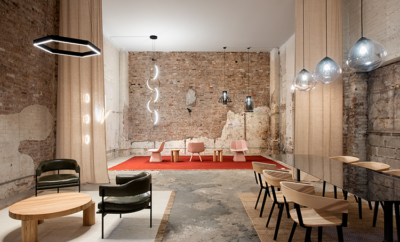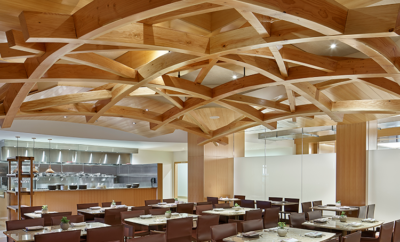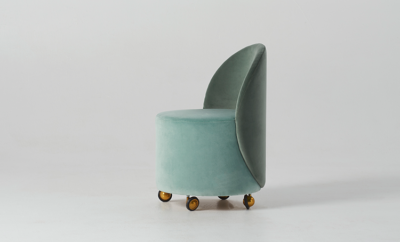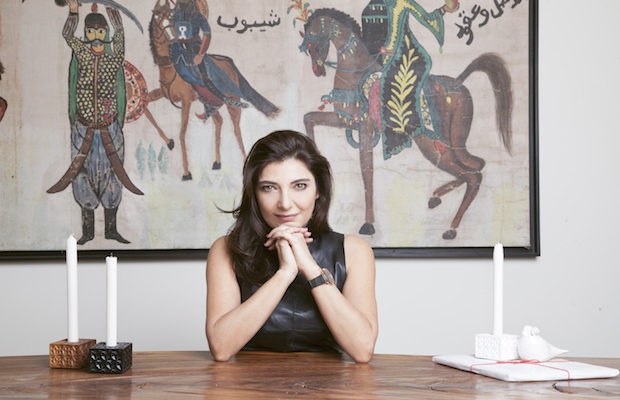 TAREK MOUKADDEM PHOTO
TAREK MOUKADDEM PHOTO
Design
Orient Re-Expressed
BEIRUT-BASED DESIGNER NADA DEBS pioneered contemporary Lebanese design. By fusing ancient Middle Eastern craft techniques with a Japanese-inspired, purist ethos, she created something that had never been seen before: furniture handmade by Lebanese artisans, using noble Middle Eastern materials like mother-of-pearl, but showcasing the geometric, minimalist lines associated with the Far East. “Craft from our region was too serious,” Debs says, speaking from her office in Gemmayzeh, one of the few areas in the Lebanese capital that still possesses the glorious Italianate homes and buildings from the late nineteenth and early twentieth centuries. “I added a freshness and newness to craft.”
That was sixteen years ago, when Debs created her Floating stool, a seemingly weightless stool featuring a transparent acrylic base. Back then, in 2001, Debs had only lived in Beirut for a single year, having grown up in Japan with her family, where she also went to school before attending the Rhode Island School of Design. Upon graduation she moved to London, where she started making furniture for herself. “In the early 1990s, there wasn’t that much contemporary furniture,” she says. “I used to go to antique shops, where I started having an appreciation for craft.”
After her first son was born, Debs created a children’s furniture line that caught the eye of friends, who then started asking her to make furniture for them. At this point she was still in London, and she found local craftspeople who could produce marquetry in color. The turning point came in 2000, when she moved to Beirut, a city that was still recovering from a violent civil war and struggling to redefine itself in the new century. “I was still doing contemporary furniture with marquetry,” Debs says. “I asked myself why I was still doing children’s items and started experimenting with grown-up furniture.”
Her exploration of local craft techniques took her to Syria, to Damascus’s old city, where she found traditional workshops plying decades-old craft methods. “I loved their craft,” Debs says, “but I wanted to show it in a contemporary light, to minimize it. This is how my Japanese side showed up. So I created a bedside table with mother-of-pearl. Every piece came from my own personal need.”
This experimentation led to her first commercial piece, the aforementioned Floating stool. “I wanted to make something unique, something that couldn’t be mass produced,” she says. “After the Floating stool came the Pebble table and then the Coffee Bean table.” To provide a showcase for her increasingly numerous and varied designs, Debs opened her first showroom in 2003, in Beirut’s ascendant, newly restored Saifi Village, which has since become a magnet for niche designers and offbeat retail stores.
In 2005, as she was starting to garner international acclaim for her work, Debs created additional pieces of furniture using mother-of-pearl and geometric patterns, following a request by Sawaya & Moroni, which wanted to exhibit her work in a special Lebanon-themed show in Paris. “I started with traditional inlay, then marquetry inlay inside resin,” she says. “I then added color and arabesque patterns. I gave traditional craft a sense of modern identity, which the Arabs didn’t have.” This combination of materials and patterns would come to define her work.
Her most celebrated designs include the Arabesque love seat, a sensually curved piece that allows people to sit tête-à-tête; the passionately executed Arabian Night mirror, made from acrylic resin in various colors and showcasing an arched top; the Pebble table, available in a rainbow of colors and featuring brass or stainless steel legs; and Le Buffet, a cabinet made from lacquered wood and sporting Debs’s signature arabesque patterns. With these pieces, Debs inadvertently became a pioneer of contemporary regional design, representing the new breed of designers who emerged from postwar Lebanon. “I’m both Arab and Japanese,” she says. “My work is about finding a balance between these two cultures, and between their materials, like concrete and mother-of-pearl, two contrasts that balance themselves.”
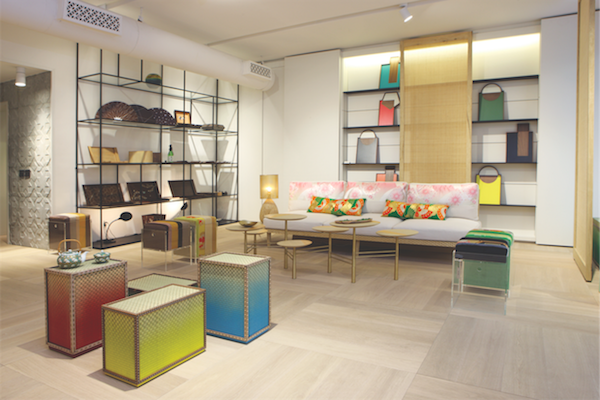
The designer’s showroom in Beirut’s Saifi Village. Mansour Deeb Photo
As her designs came into their own, Debs attracted an enviable clientele that included Arab royalty as well as governments, including those of the UAE, Jordan, and Qatar. In Saudi Arabia she’s a veritable star and perhaps one of the most recognized names in Lebanon. Beyond the Middle East, her products are available in New York at Mondo Collection and Antony Todd, and in L.A. at Aleph Gallery in Newport Beach, among others.
Last year Debs took one of her biggest gambles by launching a collection, Ants and Plants, that pushed her designs in a bold direction. “I removed arabesque, rectilinear, and mother-of-pearl elements,” she says of the group, “but retained the local craft, so you can still feel the value of a handmade piece.” The collection includes such items as plates made from olive wood, with the wood cut at an angle so that the grain stretches, preserving the organic sensuality of the natural material. There is also a table in acacia wood enhanced with tin inlay—a gracious nod to her signature mother-of-pearl, but envisioned in a new manner. Most recently, Debs has been working on developing her eponymous label into a lifestyle brand, and she’s added limited-edition scarves and bags to her offerings, as well as shoes made in collaboration with Converse, plus a line of jewelry. But her most dazzling piece is Land of the Rising Sun, a bar cabinet that’s a one-off piece from her new Now and Zen collection. The magnificent bar is round, suggesting the sun on Japan’s flag, and made of wood, embellished with stained, multicolored mother-of-pearl, carving, and tin inlay. “This piece is not rectilinear, it’s free flowing,” Debs says. “I came back to the Arab world through my own silk route.”
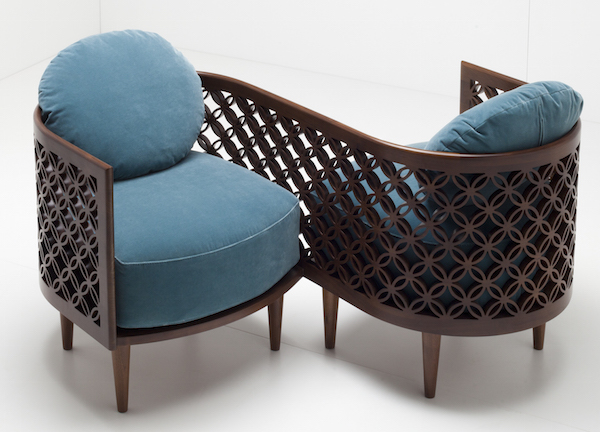
Arabesque love seat in hand-carved walnut, 2010. Nadim Asfar Photo


